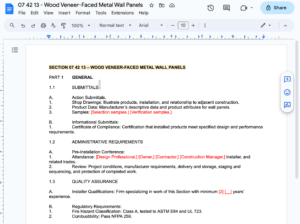Types of 3-part specifications
There’s often confusion around different types of 3-part specifications format; specifically Manufacturer Specific Specifications, Master Guide Specifications, and Project Specifications.
So, let’s unravel some of those mysteries today. 🔍
What are CSI 3-part specifications?
Before we start, lets quickly review the structure of 3-part specifications (also known as three-part specs) and how they are used to describe the requirements and standards for construction projects.
The specification is divided into three main parts: General, Products, and Execution. Each part serves a specific purpose and provides detailed information for different aspects of the project. Here’s a breakdown of each part:
Part 1 – General
This part of the specification includes the overall project requirements, procedures, and conditions that apply to the entire construction project. It covers topics such as project scope, quality control, contractor qualifications, permits, and codes or standards that must be followed.
The General section sets the groundwork and provides an overview of the project’s general expectations.
Part 2 – Products
The Products part of the specification focuses on the materials, equipment, and products to be used in the construction project. It provides detailed information about the specific requirements, performance criteria, and standards that the products must meet.
This section may include details about product types, manufacturers, model numbers, dimensions, finishes, and installation methods. It helps ensure that the specified products align with the project’s design and performance objectives.
Part 3 – Execution
The Execution part of the specification outlines the specific procedures, methods, and standards that must be followed during the construction process. It includes instructions for installation, construction techniques, testing, and quality assurance.
This section may also address coordination with other trades, sequencing of work, site protection measures, and any specific construction-related requirements. The Execution part ensures that the construction work is carried out in accordance with the project’s specifications and industry best practices.
By dividing the specifications into these three parts, the intention is to provide comprehensive guidance to the construction team, including architects, engineers, contractors, and subcontractors.
The General section establishes the project’s context, the Products section defines the required materials and products, and the Execution section details how the construction work should be executed.
Manufacturers’ Specific CSI 3-Part Spec
Manufacturers’ 3-part specs are created by product manufacturers or suppliers for the purpose of making it easier for the architect to specify their product, material or assembly.
Commonly referred to as basis of design or proprietary specs, and include information such as product properties, compositions, color options, and performance criteria.
How are they used:
– If the spec is clear, concise, complete and correct, the specification may be updated and used on a particular product.
– The design professional may also simply copy and paste information from the document and add it to to a current office specification for use.
– When the spec is complex, lengthy and time consuming to review, the design professional may elect to simply avoid the document and add the manufacturers name into a past project spec.
Here is an example:

Example
Master Guide Specifications
A Master Guide Specification, sometimes called a spec template, serves as a standardized template or reference document that provides guidance for a particular type of construction work or trade. It is developed by architects, specifiers and engineers with extensive specifying experience to make it easier to build project specifications.
This type of 3-part spec is filled with a range of options, materail options, including text to guide the user on the editing process to suit a particular project. Allowing flexibility for designers and contractors to choose the most suitable product for their project.
A Master Guide Specification in 3-Part format also provides a comprehensive framework that can be adapted to different projects. It helps streamline the specification writing process and ensures consistency in project specifications within a particular trade or industry.
Here is an example:

Example
Project Specifications in CSI 3-Part format
Project specifications are developed specifically for a particular construction project and are included as part of the project manual. These specs are created by designers, architects, and engineers to provide detailed information about the project’s requirements, materials, and execution.
The primary purpose of a project specification is to provide comprehensive guidance, specific requirements and expectations to the construction team. These are the specs you see issued during the bidding stage and reviewed during the construction phase.
Conclusion
Overall, the 3-part specifications provide a structured and organized approach. They convey project requirements, facilitating effective communication, standardization, and quality control among all stakeholders involved in the construction process. While all 3-part specifications are nearly identical, they have different purposes and are intended for different audiences.
Understanding Manufacturers’ 3-part specs are focused on specific products offered by manufacturers. Master guide specifications (specification templates) provide a standardized format used for developing project specifications.
And project specifications are tailored to the specific needs of a construction project, will assist you when reviewing, editing, and creating specifications.



